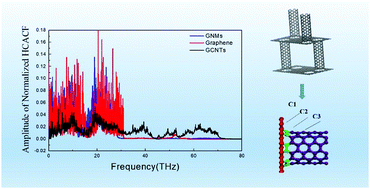Thermal conductance bottleneck of a three dimensional graphene–CNT hybrid structure: a molecular dynamics simulation†
Abstract
Three dimensional (3D) graphene–CNT hybrid structures (GCNTs) are promising materials for applications including capacitors and gas storage and separation devices, however until now their thermal conductance mechanism has scarcely been studied. These hybrid nanomaterials are particularly suitable as next-generation thermal interface materials due to the excellent thermal properties of carbon nanotubes and single atomic layer graphene. In this paper, the out-of-plane thermal conductivities of GCNTs, graphene nanomesh (GNM), and graphene sheets are investigated using molecular dynamics (MD) simulations which apply the Green–Kubo method. Distinct from GNMs and graphene sheets, the GCNTs exhibit a relatively high out-of-plane thermal conductivity, stemming from the CNTs’ ability to accelerate the energy flow. However, the GCNT out-of-plane thermal conductivity is still far lower than that of pristine graphene due to extreme phonon localizations, which are concentrated on the graphene–CNT junction regions as evidenced by the participation ratio, phonon vibrational density of states, and overlap energy. This study provides microscopic insight into the GCNT heat transfer mechanism and offers design guidelines for application of GCNTs in thermal management devices.



 Please wait while we load your content...
Please wait while we load your content...